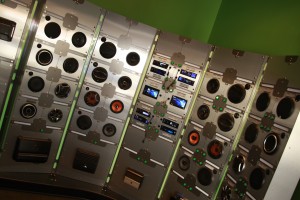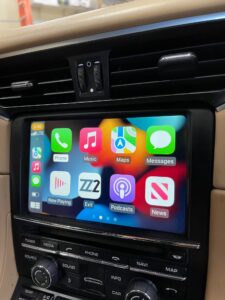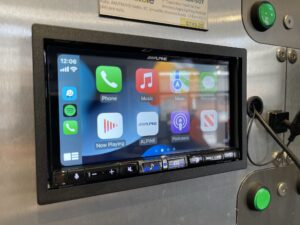Start with the head unit. I’ll teach you about what features you need to look for and why you need them. Read this before you buy an aftermarket stereo for your car!
Estimated read time: 9 minutes 33 seconds. Want to read later?
GOAL – IMPROVE SOUND QUALITY

Most consumers would assume that in order to get better sound, you should upgrade your speakers. This is true to an extent, but speakers are just one piece of the puzzle. To get truly improved sound quality, you should be upgrading everything: replacing your head unit and or using a processor, upgrading speakers, adding amps and a subwoofer. A lot of people can’t afford to do it in all one shot, so where do you start?
Start with your source. If you have a stereo that can be replaced (in other words it is not integrated into the car’s computer, heat/ac controls and someone makes a nice radio installation kit for it), start with the head unit. You could put the best speakers in your car, but if you are powering them off the stock head unit you aren’t doing yourself any good. You are limited by the power and the sound quality coming out of that stock stereo, so no matter how good of speakers you put in it, you’re only going to notice a slight improvement. You would never reach the full sound quality potential of whatever speakers you put in there until you gave them a good clean source along with proper power amplification.
First off, start with your source and not just any source. If you are going to be building a nice aftermarket system, start with a head unit that will give you a good foundation for building a nice aftermarket system. You don’t want to cheap out here. If you see yourself upgrading speakers, possibly adding amplifiers, you will need to purchase something that gives you the options to add these features later on.
Make sure you buy a head unit that has 3 high voltage pre-outs. Most aftermarket head units with a higher voltage pre-out section are rated around 4 volts. The other feature to look for, especially if you are building your system in steps, is built in crossovers that are adjustable. By having crossovers built in, you will be able to filter out certain frequencies to certain speakers. Some brands offer this adjustment separately for front speakers, rear speakers and even for the subwoofer.
If a head unit simply states built in crossover, ask the salesperson or read the find print and find out if this crossover is adjustable in any way and if they are adjustable separately for front and rear. The more flexibility you have, the better you will be able to tweak and adjust the sound in your car.
Built in crossovers will allow you to help build your system in steps. If you start with the head unit, and your current speakers are working, I usually recommend adding an amp and sub next. The subwoofer will fill in the bottom end and help create a much larger presence in your overall system. Subwoofers really balance out the entire sound system. So even if you are powering your stock speakers off the aftermarket head unit, having a subwoofer will vastly improve your overall sound.
The crossover adjustment will allow you to filter the bass out of your speakers that are currently being powered off the head unit, regardless of whether those speakers are stock or aftermarket.
Being able to adjust the crossover point separately for front and rear in different frequency increments is ideal. For example, if you have a 2002 Chevy Cavalier, your front speakers are usually a smaller 4”x6” speaker compared to the rears which are usually a much larger 6”x9” speaker. The 6”x9”’s will be capable of playing much more mid bass than the 4”x6” speakers simply due to the larger surface area of the speaker. If you have a subwoofer in the car, you are going to want to filter out some of that bass to the interior speakers. Your sub is designed for playing bass, so let’s let it do what it’s designed for and we’ll let the interior speakers do what they’re designed for.
If you owned a 2002 Chevy Cavalier that came equipped with 4″x6″ speakers in the front and 6″x9″ speakers in the rear, ideally, you would filter out 120 hertz and down from your front speakers and around 60 hertz and down on the rears. Then you would have the crossover on your amp around 80-120 hertz so that the subs would handle those lower frequencies. This way every component in your system is playing to the best of its abilities the frequencies they’re designed to play.
The other thing to look for in your aftermarket head unit is an EQ or equalizer. Try to find something with a 5-7 band EQ. The different bands represent different bands of frequencies that you can increase or decrease. The more bands you have, the more control you have, but also the easier it is to mess up the sound if you don’t know how to tune a system. For detailed tuning instructions, make sure you buy my soon to be released E-Book, the Car Stereo Bible, and read the chapter on total system tuning.

Other sound adjustment features to look for are things like time alignment or time correction. This allows you to center your sound stage around YOU regardless of where you sit in relation to your speakers. For example, in your average car, if you are the driver, the driver’s side speaker is the 1st speaker that you hear because it sits closest to you. The driver’s side rear speaker is usually the next speaker you hear, followed by the passenger side front and the passenger side rear. To test this out, next time you’re in your car and listening to your stereo (with the car in park, you don’t want to drive and do this), close your eyes. Try to pinpoint where the sound is coming from. You are going to notice the speaker that is closest to you.
Through a formula described in the tuning section of my soon to be released E-Book ,the Car Stereo Bible, you will learn how to adjust this feature. If you purchase a stereo that comes with time alignment, there should also be a section in the stereo’s owner guide describing the procedure necessary for setting time alignment. Through the process of delaying the closest speakers by milliseconds, you control what time it takes for each speaker to hit you. When set up properly, each speaker will hit your ears at the same time. After setting this up, close your eyes and listen again. You will not be able to pin point where the sound is coming from. It will envelop you and the singer’s voice will sound like they’re singing directly in front of you. It’s very cool stuff, once you have this feature you’ll want to have it in every car stereo system you ever own.
Another really cool feature that certain manufacturers offer (Kenwood in particular) is this thing called Volume Offset. If you have a vehicle that has an existing premium amplified system and you plan to start by upgrading the head unit and an amp and sub, but plan on keeping the stock speakers (and thus stock amp for now), volume offset will come in handy.
This is true of any vehicle equipped with a Bose amp that will continue to be utilized. It’s also true of any VW, Audi or BMW with a premium system (most come with it).

When you replace a factory stereo in these cars, but keep the stock amp and speakers, you are basically creating a double amplification. You are powering up the stock amp with your aftermarket head unit and you are also using the internal amp in your aftermarket head unit. So you’re technically amplifying an amplifier. This can lead to more output, but almost in increments that are too large on the volume knob. The other issue you may run into is if you then go ahead an add a subwoofer, you have to remember, the subwoofer is only receiving single amplification signal.
At this point, volume off-set will allow you to level match the stock amp with the aftermarket amp, cutting down on the over amplification. This is just one more feature that will give you more control over the sound in your system leading you to better overall sound quality.

Now that we’ve covered audio control features for your new aftermarket stereo, let’s talk about general features to look for. What good will all of these features do if you don’t know how to control the stereo? If you are not tech savvy and prefer easy to use controls, get in the store and get your hands on the stereos you are considering buying. Don’t let the salesmen do all the button touching, they should know the product they are selling like the back of their hand. Ask him or her to run you through the features and simply instruct you on how to access the features you are interested in. If it feels clumsy or confusing, it will still feel clumsy and confusing when it’s installed in your car. Make sure you are comfortable and happy with the operating system and user interface, menu’s and all controls and buttons.
How does it look? Remember, just because the stereo you want may have all the features you are looking for, it still has to be installed in your dash and you’re going to have to look at it almost every day for some period of time. Does the finish match or compliment your dash? Are there illumination options to allow you to match or compliment your interior lighting? Is the display large enough or bright enough for you to see? These are the kind of things you want to address when considering the overall look and feel of a head unit.
Other important factors to consider when purchasing your new head unit, what kind of reputation does the brand have? Do they have a long time track record as being a leading car stereo manufacturer? Has the company changed ownership recently? What kind of warranty does the manufacturer offer? What is the warranty process should any part of the aftermarket stereo fail?
Other considerations to make are what kind of cool tech features does the radio have that you desire? Navigation? Bluetooth? A2DP audio streaming? USB/Aux? Ask the salesperson what kind of cool technology has come out recently. Often times that can be your tipping point between picking one model or brand over another. You don’t want to miss out on something cool that might be unique to one brand and even maybe one model in particular, so ask questions.
Ask the salesperson to demonstrate the features you are interested in. This way you can be sure that they work properly and in a manner that you can understand. If you wanted the feature of bluetooth handsfree, try your phone with the stereo on the display. If you try pairing your phone and the stereo keeps dropping the bluetooth connection, then it doesn’t matter if the stereo has bluetooth. If it doesn’t work with your phone, you probably shouldn’t buy it. Any very important features should be demonstrated so that you can feel confident they will work in the manner you desire.
With all of this knowledge gathered, your decision is kind of like the decision to buy a house. You can’t always check every thing off your wish list so you need to decide what factors and features are most important to you and make your purchasing decision is based off that. It will help to write down the features that are most important to you and have that list with you when you go shopping. The sales person may spout off the features too fast for you to register them, so it helps to have a list that will allow you to clarify which models have the features on your wish list.
What if you don’t have a good car stereo store in your area? Do as much research as you can online based on the feature list you came up with. Have a few different models to choose from and then start reading about them. You can find detailed reviews of products on websites like Crutchfield.com (also a good, reputable source for buying car stereo online) which has user reviews for almost everything they sell. There are many places to find reviews online. Keep in mind, some people only write reviews because they’re unhappy with the product and need an outlet to vent. So be careful from letting one bad reviewer deter you from the product you want.
I still recommend trying to find a store near you that will allow you to speak with a real salesperson that can demonstrate the product that suits your needs. I have some customers that drive an hour and half away just to be able to do that. If you end up going down that road, I recommend calling first to speak with a salesperson. Feel them out, see if they’re genuinely interested in helping you and make sure they carry and display the products you are interested in possibly purchasing.

What if a head unit isn’t an option for you? Then you need to consider a processor that will allow you to integrate better quality aftermarket equipment with your stock head unit. Brands to check out would be JL Audio, Audison and Audio Control. These companies have a known reputation for creating excellent integration processors. You can read more about these options in my upcoming E-Book, the Car Stereo Bible. Thanks for stopping by and reading this post. Good luck shopping for your new car stereo!




3 Comments
The author’s expertise shines through as they guide readers on the crucial first step in building a top-notch car stereo setup. I appreciate how the article emphasizes the importance of investing in a high-quality head unit, which serves as the foundation for exceptional sound quality and functionality. The author’s clear and concise explanations make it easy for readers to understand the rationale behind their recommendations. This article is a must-read for car enthusiasts seeking to elevate their driving experience with an outstanding car stereo system.
Good day, your advices are the best that i have read on the internet i iwish all car audio enthusiast will be as informative as you are specially for newbees like me..i want to upgrade my stock stereo system and i want to do it via do-it-yourself way. I already have a somwhat clear picture with regards to subs and amps. My plan is to get first a nice HU and decent separates and power it initially with Hu’s built in amp. Just want to ask if the time that im ready to put subs and amp, do i need to disconnect speaker wires in the harness? Or how should i do it with the pre outs and will the pre outs give a left and right input on the amp…thanks. Sorry for the dumb question, if some would think so..
Hi Dante,
That’s a pretty common question I get from customers when installing a 4 channel amp. You’ve got the right idea. You would disconnect the wires in the speaker harness going to the aftermarket deck. It’s common for people to then run 4 sets of speaker wires (Front Left, Front Right, Rear Left, Rear Right) from that disconnected harness back to the amp. You’re basically just taking the speaker wire that’s coming out of the car harness, disconnecting it from going into the head unit, then extending it from there back to the 4 channel.
You could technically run all new speaker wire, but I don’t think that is necessary unless you are running some serious power to the speakers. Typical factory wire is 18 gauge. You would then use RCA’s to go from the preouts of the deck to the amp. If you install a 4 channel, you’ll need 2 sets of RCA’s. One set for the for the front channel and one set for the rear channel.
Make sure you get a head unit that has a high voltage preout section with preouts for front, rear and subwoofer so you can add your amps when you’re ready. let me know if you have any more questions I can help you with. Thanks for commenting, I’m glad you find the website helpful!